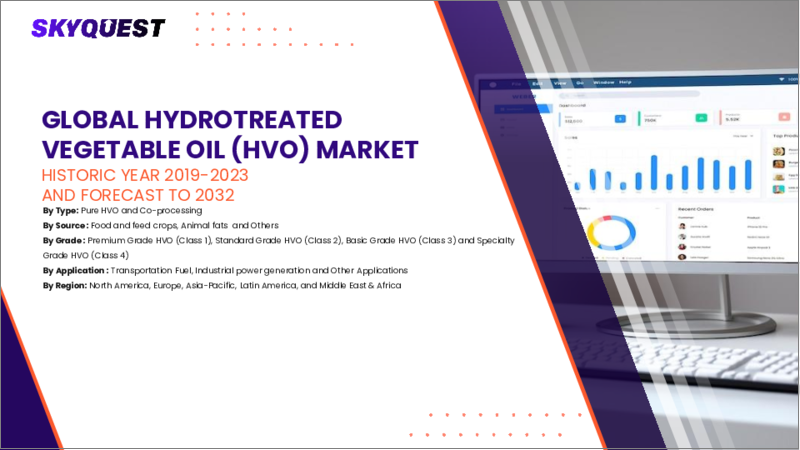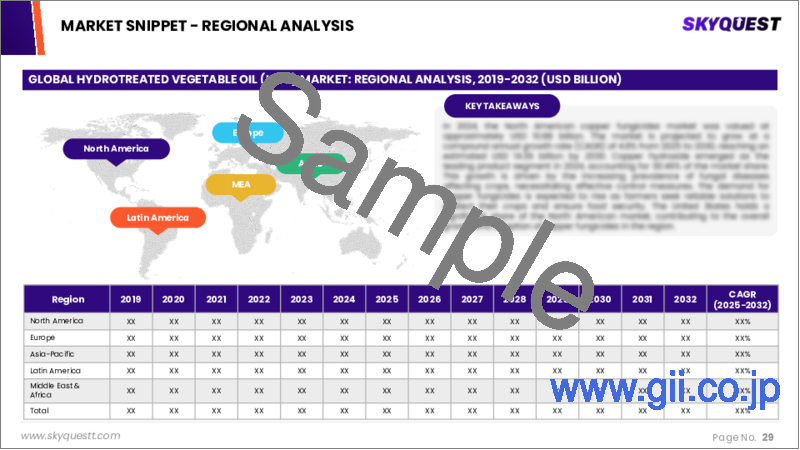|
|
市場調査レポート
商品コード
1643678
HVOの市場規模、シェア、成長分析:供給源別、グレード別、技術別、用途別、地域別 - 産業予測 2025~2032年HVO Market Size, Share, Growth Analysis, By Source, By Grade, By Technology, By Application, By Region - Industry Forecast 2025-2032 |
||||||
|
|||||||
| HVOの市場規模、シェア、成長分析:供給源別、グレード別、技術別、用途別、地域別 - 産業予測 2025~2032年 |
|
出版日: 2025年01月22日
発行: SkyQuest
ページ情報: 英文 271 Pages
納期: 3~5営業日
|
全表示
- 概要
- 目次
HVO(水素化処理植物油)の世界市場規模は、2023年に18億米ドルと評価され、2024年の18億8,000万米ドルから2032年には26億5,000万米ドルに成長し、予測期間(2025-2032年)のCAGRは4.4%で成長する見通しです。
水素化処理市場は、バイオマスディーゼル生産のための従来のエステル化手法に代わる実行可能な選択肢として、HVO(水素化処理植物油)および水素化処理エステル・脂肪酸(HEFA)へのシフトを強めています。高セタン価で有害成分を含まないHVOとHEFAは、窒素酸化物の排出を低減し、低温流動性を改善しながら、エンジン適合性を高めます。航空用バイオ燃料として承認されたことで、その汎用性がさらに強調されました。バイオ燃料需要の急増、政府の支援政策、二酸化炭素排出量削減の急務に後押しされ、HVOセクターは成長を続けています。しかし、原料の入手可能性、生産コストの高さ、安価な化石燃料との競合といった課題は依然として重要なハードルとなっています。HVOの市場ポテンシャルを最大化するには、インフラとテクノロジーへの投資が不可欠です。
目次
イントロダクション
- 調査の目的
- 調査範囲
- 定義
調査手法
- 情報調達
- 二次データと一次データの方法
- 市場規模予測
- 市場の前提条件と制限
エグゼクティブサマリー
- 世界市場の見通し
- 供給と需要の動向分析
- セグメント別機会分析
市場力学と見通し
- 市場概要
- 市場規模
- 市場力学
- 促進要因と機会
- 抑制要因と課題
- ポーターの分析
主な市場の考察
- 重要成功要因
- 競合の程度
- 主な投資機会
- 市場エコシステム
- 市場の魅力指数(2024年)
- PESTEL分析
- マクロ経済指標
- バリューチェーン分析
- 価格分析
- 規制分析
世界のHVO(水素化処理植物油)市場規模:供給源別 & CAGR(2025-2032)
- 市場概要
- 食用および飼料作物
- 大豆油
- キャノーラ油
- ひまわり油
- パーム油
- その他
- 動物性脂肪
- 牛脂
- ラード
- 使用済み食用油
- パーム油工場の排水
- その他(非食用植物油藻類油精製製品別)
世界のHVO(水素化処理植物油)市場規模:グレード別 & CAGR(2025-2032)
- 市場概要
- クラス1:プレミアムグレード HVO
- クラス2:標準グレード HVO
- クラス3:基礎グレードHVO
- クラス4:特殊グレードHVO
世界のHVO(水素化処理植物油)市場規模:技術別 & CAGR(2025-2032)
- 市場概要
- 独立型水素化処理技術
- 共処理技術
世界のHVO(水素化処理植物油)市場規模:用途別 & CAGR(2025-2032)
- 市場概要
- 持続可能な航空燃料
- 自動車燃料
- 船舶燃料
- 産業用発電
- 暖房燃料
- 農業機械燃料
- 潤滑剤
世界のHVO(水素化処理植物油)市場規模:地域別& CAGR(2025-2032)
- 北米
- 米国
- カナダ
- 欧州
- ドイツ
- スペイン
- フランス
- 英国
- イタリア
- その他欧州地域
- アジア太平洋地域
- 中国
- インド
- 日本
- 韓国
- その他アジア太平洋地域
- ラテンアメリカ
- ブラジル
- その他ラテンアメリカ地域
- 中東・アフリカ
- GCC諸国
- 南アフリカ
- その他中東・アフリカ
競合情報
- 上位5社の比較
- 主要企業の市場ポジショニング(2024年)
- 主な市場企業が採用した戦略
- 市場の最近の動向
- 企業の市場シェア分析(2024年)
- 主要企業の企業プロファイル
- 会社概要
- 製品ポートフォリオ分析
- セグメント別シェア分析
- 収益の前年比比較(2022-2024)
主要企業プロファイル
- Neste(Finland)
- REG(Renewable Energy Group)(USA)
- Preem AB(Sweden)
- Eni S.p.A.(Italy)
- TotalEnergies SE(France)
- Shell plc(UK)
- ExxonMobil Corporation(USA)
- Chevron Corporation(USA)
- Valero Energy Corporation(USA)
- Phillips 66(USA)
- Diamond Green Diesel(USA)
- World Energy(USA)
- SkyNRG(Netherlands)
- Neste MY Renewable Diesel(Singapore)
- UPM-Kymmene Corporation(Finland)
- Repsol(Spain)
- VARO Energy(Switzerland)
- Galp(Portugal)
- MOL Group(Hungary)
- Indian Oil Corporation Ltd(India)
結論と推奨事項
Global HVO (Hydrotreated Vegetable Oil) Market size was valued at USD 1.8 billion in 2023 and is poised to grow from USD 1.88 billion in 2024 to USD 2.65 billion by 2032, growing at a CAGR of 4.4% during the forecast period (2025-2032).
The hydroprocessing market is increasingly shifting towards Hydrotreated Vegetable Oil (HVO) and Hydro-processed Esters and Fatty Acids (HEFA) as viable alternatives to traditional esterification methods for biomass diesel production. Featuring high cetane numbers and lacking harmful components, HVO and HEFA enhance engine compatibility while offering reduced nitrogen oxide emissions and improved cold flow properties. Their approval as aviation biofuels further underscores their versatility. Driven by surging biofuel demand, supportive government policies, and the urgent need to cut carbon emissions, the HVO sector is positioned for growth. However, challenges such as feedstock availability, high production costs, and competition from cheaper fossil fuels remain critical hurdles. Investments in infrastructure and technology are essential for maximizing HVO's market potential.
Top-down and bottom-up approaches were used to estimate and validate the size of the Global HVO (Hydrotreated Vegetable Oil) Market and to estimate the size of various other dependent submarkets. The research methodology used to estimate the market size includes the following details: The key players in the market were identified through secondary research, and their market shares in the respective regions were determined through primary and secondary research. This entire procedure includes the study of the annual and financial reports of the top market players and extensive interviews for key insights from industry leaders such as CEOs, VPs, directors, and marketing executives. All percentage shares split, and breakdowns were determined using secondary sources and verified through Primary sources. All possible parameters that affect the markets covered in this research study have been accounted for, viewed in extensive detail, verified through primary research, and analyzed to get the final quantitative and qualitative data.
Global HVO (Hydrotreated Vegetable Oil) Market Segments Analysis
Global HVO (Hydrotreated Vegetable Oil) Market is segmented by Source, Grade, Technology, Application and region. Based on Source, the market is segmented into Food and feed crops, Animal fats and Others (non-edible vegetable oil, algae oils, and refining byproducts). Based on Grade, the market is segmented into Class 1: premium grade HVO, Class 2: standard grade HVO, Class 3: basic grade HVO and Class 4: specialty grade HVO. Based on Technology, the market is segmented into Standalone hydrotreating technology and Co-processing technology. Based on Application, the market is segmented into Sustainable aviation fuel, Automotive fuel, Marine fuel, Industrial power generation, Heating fuel, Agricultural equipment fuel and Lubricants. Based on region, the market is segmented into North America, Europe, Asia Pacific, Latin America and Middle East & Africa.
Driver of the Global HVO (Hydrotreated Vegetable Oil) Market
Global Hvo, or Hydrotreated Vegetable Oil, is an advanced biofuel derived from renewable biological resources, offering a sustainable alternative to conventional fossil fuels. Produced through a refining process that hydrogenates vegetable oils or animal fats, Hvo boasts a high cetane number and low nitrogen oxide emissions, making it a cleaner-burning fuel compatible with existing diesel engines. Its properties allow for seamless blending with diesel, ensuring a smooth transition for operators. As environmental regulations tighten and demand for sustainable energy sources rises, Global Hvo stands out as a viable solution to reduce greenhouse gas emissions and promote energy security globally.
Restraints in the Global HVO (Hydrotreated Vegetable Oil) Market
Global Hydrotreated Vegetable Oil (HVO) production faces several constraints that could hinder its widespread adoption and scalability. These include limited feedstock availability, as HVO primarily relies on sustainable vegetable oils and animal fats, which are subject to competing demands for food and land use. Additionally, the technological infrastructure required for HVO production can be capital-intensive, posing barriers for smaller players in the renewable energy sector. Regulatory challenges, including inconsistent policies and sustainability certification requirements, may also impact market growth. Lastly, competition from other renewable fuels could limit HVO's market share and investment prospects in the broader landscape of biofuels.
Market Trends of the Global HVO (Hydrotreated Vegetable Oil) Market
The Global Hydrotreated Vegetable Oil (HVO) market is witnessing a significant upward trend, propelled by the escalating demand for renewable fuels amid mounting climate change concerns. This market, characterized by its low-carbon profile, primarily utilizes sustainable feedstocks, including vegetable oils and animal fats, aligning with global strategies to mitigate greenhouse gas emissions. As regulatory frameworks tighten and governments implement stringent policies aimed at reducing the carbon footprint of transportation and industrial operations, HVO is increasingly seen as a viable alternative to conventional fossil fuels. Key industry players are responding to this shift with substantial investments to bolster production capabilities, signaling a robust growth trajectory for the HVO market in the coming years.
Table of Contents
Introduction
- Objectives of the Study
- Scope of the Report
- Definitions
Research Methodology
- Information Procurement
- Secondary & Primary Data Methods
- Market Size Estimation
- Market Assumptions & Limitations
Executive Summary
- Global Market Outlook
- Supply & Demand Trend Analysis
- Segmental Opportunity Analysis
Market Dynamics & Outlook
- Market Overview
- Market Size
- Market Dynamics
- Drivers & Opportunities
- Restraints & Challenges
- Porters Analysis
- Competitive rivalry
- Threat of substitute
- Bargaining power of buyers
- Threat of new entrants
- Bargaining power of suppliers
Key Market Insights
- Key Success Factors
- Degree of Competition
- Top Investment Pockets
- Market Ecosystem
- Market Attractiveness Index, 2024
- PESTEL Analysis
- Macro-Economic Indicators
- Value Chain Analysis
- Pricing Analysis
- Regulatory Analysis
Global HVO (Hydrotreated Vegetable Oil) Market Size by Source & CAGR (2025-2032)
- Market Overview
- Food and feed crops
- Soybean oil
- Canola oil
- Sunflower oil
- Palm oil
- Others
- Animal fats
- Tallow
- Lard
- Used cooking oils
- Palm oil mill effluent
- Others (Non-edible vegetable oil, Algae oils, and Refining byproducts)
Global HVO (Hydrotreated Vegetable Oil) Market Size by Grade & CAGR (2025-2032)
- Market Overview
- Class 1: premium grade HVO
- Class 2: standard grade HVO
- Class 3: basic grade HVO
- Class 4: specialty grade HVO
Global HVO (Hydrotreated Vegetable Oil) Market Size by Technology & CAGR (2025-2032)
- Market Overview
- Standalone hydrotreating technology
- Co-processing technology
Global HVO (Hydrotreated Vegetable Oil) Market Size by Application & CAGR (2025-2032)
- Market Overview
- Sustainable aviation fuel
- Automotive fuel
- Marine fuel
- Industrial power generation
- Heating fuel
- Agricultural equipment fuel
- Lubricants
Global HVO (Hydrotreated Vegetable Oil) Market Size & CAGR (2025-2032)
- North America (Source, Grade, Technology, Application)
- US
- Canada
- Europe (Source, Grade, Technology, Application)
- Germany
- Spain
- France
- UK
- Italy
- Rest of Europe
- Asia Pacific (Source, Grade, Technology, Application)
- China
- India
- Japan
- South Korea
- Rest of Asia-Pacific
- Latin America (Source, Grade, Technology, Application)
- Brazil
- Rest of Latin America
- Middle East & Africa (Source, Grade, Technology, Application)
- GCC Countries
- South Africa
- Rest of Middle East & Africa
Competitive Intelligence
- Top 5 Player Comparison
- Market Positioning of Key Players, 2024
- Strategies Adopted by Key Market Players
- Recent Developments in the Market
- Company Market Share Analysis, 2024
- Company Profiles of All Key Players
- Company Details
- Product Portfolio Analysis
- Company's Segmental Share Analysis
- Revenue Y-O-Y Comparison (2022-2024)
Key Company Profiles
- Neste (Finland)
- Company Overview
- Business Segment Overview
- Financial Updates
- Key Developments
- REG (Renewable Energy Group) (USA)
- Company Overview
- Business Segment Overview
- Financial Updates
- Key Developments
- Preem AB (Sweden)
- Company Overview
- Business Segment Overview
- Financial Updates
- Key Developments
- Eni S.p.A. (Italy)
- Company Overview
- Business Segment Overview
- Financial Updates
- Key Developments
- TotalEnergies SE (France)
- Company Overview
- Business Segment Overview
- Financial Updates
- Key Developments
- Shell plc (UK)
- Company Overview
- Business Segment Overview
- Financial Updates
- Key Developments
- ExxonMobil Corporation (USA)
- Company Overview
- Business Segment Overview
- Financial Updates
- Key Developments
- Chevron Corporation (USA)
- Company Overview
- Business Segment Overview
- Financial Updates
- Key Developments
- Valero Energy Corporation (USA)
- Company Overview
- Business Segment Overview
- Financial Updates
- Key Developments
- Phillips 66 (USA)
- Company Overview
- Business Segment Overview
- Financial Updates
- Key Developments
- Diamond Green Diesel (USA)
- Company Overview
- Business Segment Overview
- Financial Updates
- Key Developments
- World Energy (USA)
- Company Overview
- Business Segment Overview
- Financial Updates
- Key Developments
- SkyNRG (Netherlands)
- Company Overview
- Business Segment Overview
- Financial Updates
- Key Developments
- Neste MY Renewable Diesel (Singapore)
- Company Overview
- Business Segment Overview
- Financial Updates
- Key Developments
- UPM-Kymmene Corporation (Finland)
- Company Overview
- Business Segment Overview
- Financial Updates
- Key Developments
- Repsol (Spain)
- Company Overview
- Business Segment Overview
- Financial Updates
- Key Developments
- VARO Energy (Switzerland)
- Company Overview
- Business Segment Overview
- Financial Updates
- Key Developments
- Galp (Portugal)
- Company Overview
- Business Segment Overview
- Financial Updates
- Key Developments
- MOL Group (Hungary)
- Company Overview
- Business Segment Overview
- Financial Updates
- Key Developments
- Indian Oil Corporation Ltd (India)
- Company Overview
- Business Segment Overview
- Financial Updates
- Key Developments






